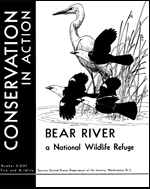United States Fish and Wildlife Service

United States Fish and Wildlife Service: Publications
Date of this Version
2011
Citation
U.S. Fish and Wildlife Service. 2011. Waterfowl population status, 2011. U.S. Department of the Interior, Washington, D.C. USA.
Abstract
In the traditional survey area, which includes strata 1-18, 20-50, and 75-77, the total duck population estimate was 45.6 ± 0.8 [SE] million birds. This estimate represents an 11% increase over last year's estimate of 40.9 ± 0.7 million birds and was 35% above the long-term average (1955-2010). Estimated mallard (Anas platyrhynchos) abundance was 9.2 ± 0.3 million birds, which was 9% above the 2010 estimate of 8.4 ± 0.3 million birds and 22% above the long-term average. Estimated abundance of gadwall (A. strepera; 3.3 ± 0.2 million) was similar to the 2010 estimate and 80% above the long-term average. Estimated abundance of American wigeon (A. americana; 2.1 ± 0.1 million) was 14% below the 2010 estimate and 20% below the long-term average. The estimated abundance of green-winged teal (A. crecca) was 2.9 ± 0.2 million, which was 17% below the 2010 estimate and 47% above their long-term average. The estimate of blue-winged teal abundance (A. discors) was 8.9 ± 0.4 million, which was 41% above the 2010 estimate and 91% above their long-term average. The estimate for northern pintails (A. acuta; 4.4 ± 0.3 million) was 26% above the 2010 estimate, and similar to the long-term average. The northern shoveler estimate (A. clypeata) was 4.6 ± 0.2 million, which was 14% above the 2010 estimate and 98% above the long-term average. Redhead abundance (Aythya americana; 1.4 ± 0.1 million) was 27% above the 2010 estimate and 106% above the long-term average. The canvasback estimate (A. valisineria; 0.7 ± 0.05 million) was similar to the 2010 estimate and 21% above the long-term average. Estimated abundance of scaup (A. affinis and A. marila combined; 4.3 ± 0.3 million) was similar to that of 2010 and 15% below the long-term average of 5.1 ± 0.05 million. Habitat conditions during the 2011 Waterfowl Breeding Population and Habitat Survey were characterized by average to above-average moisture and a normal winter and spring across the traditional and eastern survey areas. The exception was the west-central portion of the traditional survey area that received below-average moisture. The total pond estimate (Prairie Canada and U.S. combined) was 8.1 ± 0.2 million. This was 22% above the 2010 estimate and 62% above the long-term average (1974-2010) of 5.0 ± 0.03 million ponds. The 2011 estimate of ponds in Prairie Canada was 4.9 ± 0.2 million. This was 31% above last year's estimate (3.7 ± 0.2 million) and 43% above the long-term average (1961-2010; 3.4 ± 0.03 million). The 2011 pond estimate for the north-central U.S. was 3.2 ± 0.1 million, which was similar to last year's estimate (2.9 ± 0.1 million) and 102% above the long-term average (1974-2010; 1.6 ± 0.02 million). The projected mallard fall-flight index is 11.9 ± 1.1 million birds. The eastern survey area was restratified in 2005 and is now composed of strata 51-72. Estimated abundance of mallards in the eastern survey area was 0.4 ± 0.1 million, which was similar to the 2010 estimate and the long-term average (1990-2010). Abundance estimates of green-winged teal, ring-necked duck (A. collaris), goldeneyes (common [Bucephala clangula] and Barrow's [B. islandica]), and mergansers (red-breasted [Mergus serrator], common [M. merganser], and hooded [Lophodytes cucullatus]) were all similar to their 2010 estimates and long-term averages. The American black duck (Anas rubripes) estimate was 0.55 ± 0.04 million, which was similar to the 2010 estimate and 13% below the long-term average of 0.63 million.

